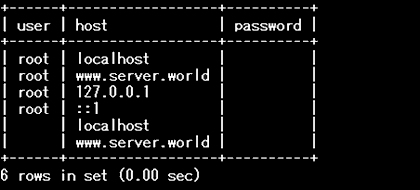|
Install MySQL
2011/05/29 |
| Install MySQL for Database Server. |
|
[root@www ~]#
[root@www ~]# yum -y install mysql-server /etc/rc.d/init.d/mysqld start Starting mysqld (via systemctl): Initializing MySQL database: Installing MySQL system tables... OK Filling help tables... OK To start mysqld at boot time you have to copy support-files/mysql.server to the right place for your system PLEASE REMEMBER TO SET A PASSWORD FOR THE MySQL root USER ! To do so, start the server, then issue the following commands: /usr/bin/mysqladmin -u root password 'new-password' /usr/bin/mysqladmin -u root -h www.srv.world password 'new-password' Alternatively you can run: /usr/bin/mysql_secure_installation which will also give you the option of removing the test databases and anonymous user created by default. This is strongly recommended for production servers. See the manual for more instructions. You can start the MySQL daemon with: cd /usr ; /usr/bin/mysqld_safe & You can test the MySQL daemon with mysql-test-run.pl cd /usr/mysql-test ; perl mysql-test-run.pl Please report any problems with the /usr/bin/mysqlbug script! [ OK ] Starting mysqld: [ OK ] [ OK ][root@www ~]# chkconfig mysqld on [root@www ~]# mysql -u root # connect to MySQL Welcome to the MySQL monitor. Commands end with ; or \g. Your MySQL connection id is 2 Server version: 5.5.12 MySQL Community Server (GPL) Copyright (c) 2000, 2010, Oracle and/or its affiliates. All rights reserved. Oracle is a registered trademark of Oracle Corporation and/or its affiliates. Other names may be trademarks of their respective owners. Type 'help;' or '\h' for help. Type '\c' to clear the current input statement. # show user info mysql> select user,host,password from mysql.user;  # set root password mysql> set password for root@localhost=password('password'); Query OK, 0 rows affected (0.00 sec) # set root password mysql> set password for root@'127.0.0.1'=password('password'); Query OK, 0 rows affected (0.00 sec) # set root password mysql> set password for root@'www.srv.world'=password('password'); Query OK, 0 rows affected (0.00 sec) select user,host,password from mysql.user;  # delete IPV6 user mysql> delete from mysql.user where user='root' and host='::1'; Query OK, 1 rows affected (0.00 sec) # delete anonymous user mysql> delete from mysql.user where user=''; Query OK, 2 rows affected (0.00 sec) select user,host,password from mysql.user;  exit # quit Bye [root@www ~]# mysql -u root -p # connect with root Enter password: # MySQL root password Welcome to the MySQL monitor. Commands end with ; or \g. Your MySQL connection id is 2 Server version: 5.5.12 MySQL Community Server (GPL) Copyright (c) 2000, 2010, Oracle and/or its affiliates. All rights reserved. Oracle is a registered trademark of Oracle Corporation and/or its affiliates. Other names may be trademarks of their respective owners. Type 'help;' or '\h' for help. Type '\c' to clear the current input statement.mysql> exit Bye |